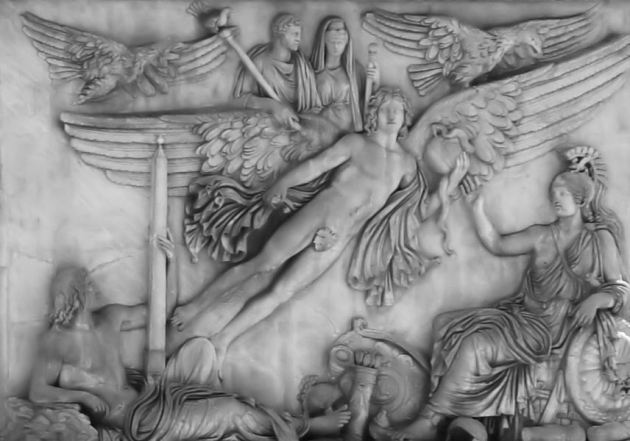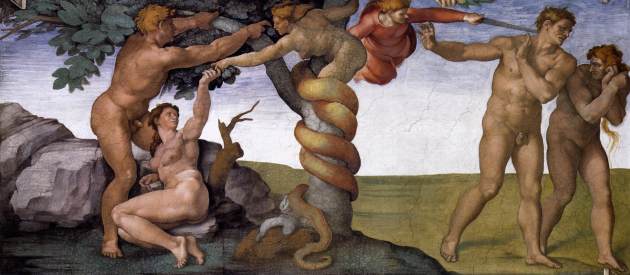
This is part 2 of my series of posts on adoptionist Christology in early Christianity. This post will focus on the Roman imperial cult and how Jesus can be seen as an alternative to emperor worship, with his narratives being modeled after stories of the emperor.
–––––––––––––––––––––––––––––––––––––––––––––––––––––––
As we saw in Part 1 of this series, there are notable similarities between the depictions of Jesus and those of the Roman emperor. In many ways it appears that Mark was modeling his baptism narrative, after a coronation ceremony of the emperor or king [1] It was also briefly mentioned that Jesus was seen by many followers as well as many pagans, as being in direct competition with worship of the emperor. As Ferguson notes, the Greco-Roman ruler cult is of particular importance to the study of early Christianity, “because it formed the focal point of the early church’s conflict with paganism.” [2]
The Development of the Ruler Cult
Following his assassination in 42 BCE, Julius Caesar was retroactively deified by decree of the Roman senate and was granted the title, Divus Iulius (the divine Julius). With his father becoming deified as ‘the god of Rome,’ Octavian, the adopted son of Caesar, assumed the title divi filius (son of god). [3]
After the deification of Caesar, both Antony and Octavian worked to promote the cult of the divine Julius which laid the framework for what would become the Roman Imperial cult (or emperor cult).
The emperor cult of Rome was greatly influenced by the Greeks who, beginning with Alexander the Great, provided the foundations for the divine monarchy of the west.
The Egyptian belief in the divinity of the Pharaoh also plays a role in leading to the development of the Roman ruler cult. The Pharaoh was believed by the Egyptians to have assumed divine status in some sense. Not necessarily in the sense that he himself was divine, but that he was the recipient of a divine office by the gods. Still, the claims of his divine status were taken very seriously by the Egyptians and he was certainly not seen as a mortal.
Even for the Yahweh cult, the king of Israel was recognized to be god’s adopted son at the moment of his enthronement ceremony. This is demonstrated in Psalm 2.7 where David is adopted as God’s son. Even in 2 Samuel 7 there is evidence of this theme:
12 When your days are fulfilled and you lie down with your ancestors, I will raise up your offspring after you, who shall come forth from your body, and I will establish his kingdom. 13 He shall build a house for my name, and I will establish the throne of his kingdom forever. 14 I will be a father to him, and he shall be a son to me. […] 15 But I will not take my steadfast love from him […] 16 Your house and your kingdom shall be made sure forever before me; your throne shall be established forever. (2 Samuel 7.12-16)
There God is making a clear commitment to David that his family line will always be in God’s favor, and that his sons will rule as king and be the sons of God. It is for this reason that it was so important for Matthew and Luke to establish Jesus’ connection to the Davidic line.
From here it seems very likely that the Roman enthronement ceremony was influenced in part by the Egyptian, Judean, and Greek concepts of divine kingship. For after Octavian, it became through that family line that the emperor would come. To be the son of god from there on literally meant to be the son of the emperor. This is the same mode by which the Davidic line and the king of Israel was established. [4] This is crucial to understanding Jesus as a divine son of god and the messiah.
Before we continue, we need to further establish characteristics of the ruler cults and the story of Jesus, beginning with birth narratives and miracle stories.
Birth Narratives & Miracle Stories
Following the death of Alexander, all his divine titles (Pharaoh, King, etc.) were given to his successors, the Ptolemies and the Seleucids. While they were viewed and respected as gods, they obviously could not act as gods with any supernatural abilities to show for. Since miracle stories at the time did not circulate for kings, they had to manufacture them. This also served as a method legitimizing their rule. Other modes of legitimizing a king’s claim included faking genealogies, and creating miraculous birth narratives. [5]
Both Matthew and Luke, when trying to establish Jesus as a divine son of god and the Jewish messiah, modeled their narratives, not only after Old Testament infancy narratives of Israeli heroes, but also after biographies of Hellenistic heroes. However, one thing to note is that the ancients did not believe that these heroes were the sons of god because it said so on a birth certificate, but because of the “extraordinary qualities of their adult lives.” Thus, the infancy narratives about these perceived ‘miraculous’ heroes, were composed later in their life or after their death.
With that we can deduce that Matthew and Luke are using the same literary tools already in play in the Greco-Roman era to depict Jesus as a ‘miraculous hero’ by giving him a miraculous infancy narrative like the other heroes.
There are a few key characteristics of these Hellenistic birth stories. Notice how these are all at play in the infancy stories in the New Testament. [7]
#1. They were in some way fathered by a god, making them the son of god. (Matt. 1.18, Luke 1.34-35)
#2. They usually begin with a genealogy that traces the individual back to a deity or a royal family. These were pretty much all fake genealogies as well. (Matt. 1.1-17)
#3. There is an announcement from a god (in ancient Judaism, angels were seen as lower tier gods [5]) in which the parents learn about the divine nature and destiny of their new child. (Luke 1.26-38)
#4. There are descriptions of signs that mark the birth of the of the child. (Matt. 2.2, 2.9)
Again it is clear that both Luke and Matthew used the literary techniques of Greek myths and well known writings when writing their own. By that they could justify Jesus as being the son of god, and a miraculous individual. [8]
Summary
So that’s a little background information. To summarize: After his assassination in 44 BCE, Julius Caesar was declared god of Rome, given the title Divus Iulius. During his lifetime, Caesar had adopted Gaius Octavius (Octavian, later Augustus) as his son making him his successor. Octavian then assumed the title Divi Filius, or son of god. From there the successor to the throne became the son of the emperor, also making him the son of god. This was the case for the Roman empire or which Israel was under the rule of, during Jesus’ lifetime. The baptism story in Mark can well be interpreted as an enthronement ceremony of the emperor where he was made the son of god. In the Mark however it is Jesus’ baptism that makes him the son of god.
The infancy stories about Jesus in Matthew and Luke are best understood as posthumous in their composition, modeled after miraculous birth stories of Jewish and Greek heroes. These stories use the literary devices of well known Greek stories and are employed as a way to justify Jesus’ titles of ‘messiah’ and ‘son of god.’
The next post will directly focus on comparing narratives of the emperor with narratives of Jesus and how the worship of Jesus can be seen as a challenge or alternative to the emperor cult.
References:
[1] for an extensive commentary on this, see Michael Peppard’s article “The Eagle and the Dove: Roman Imperial Sonship and the Baptism of Jesus” in New Testament Studies 56
[2] see Everett Ferguson’s Backgrounds of Early Christianity ch. 3 pp. 185
[3] see Dio Cassius, Roman History book 44
[4] to get a comprehensive survey of ancient concepts of divine kingship in Egypt, Syria, Judah, and Greece, see John and Adela Collins’ book King and Messiah as Son of God ch. 1 pp. 1-24
[5] Ferguson, pp. 190-191
[6] see Bart Ehrman, The New Testament pp. 63
[7] see Robert J. Miller’s Born Divine pp. 133-144
[8] Dennis MacDonald has a great section in his book Mythologizing Jesus: From Jewish Teacher to Epic Hero in which he shows the literary borrowing of Luke from The Homeric Hymn of Aphrodite. Here he displays a side by side analysis of the announcement of the birth of Jesus and the announcement of the birth of Aeneas.
[9] see Dio Cassius, History of Rome book 45
–M




 Last night, I watched the 2014 horror film, Annabelle. The movie is set up as a prequel to The Conjuring. Since I really liked the Conjuring and am looking forward to the sequel when it comes out this summer, I thought i’d give Annabelle a shot. Typically, I’m not a fan of prequel films and find them to be vastly underwhelming. Case and point––Dominion: The Prequel to the Exorcist (in all fairness it was made 30 years after the original was released). Even the prequel to Insidious, Insidious III was really underwhelming in comparison to the first two installments.
Last night, I watched the 2014 horror film, Annabelle. The movie is set up as a prequel to The Conjuring. Since I really liked the Conjuring and am looking forward to the sequel when it comes out this summer, I thought i’d give Annabelle a shot. Typically, I’m not a fan of prequel films and find them to be vastly underwhelming. Case and point––Dominion: The Prequel to the Exorcist (in all fairness it was made 30 years after the original was released). Even the prequel to Insidious, Insidious III was really underwhelming in comparison to the first two installments.